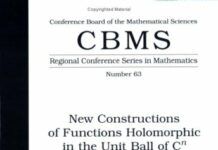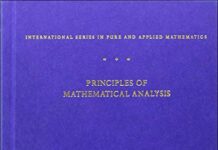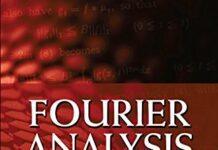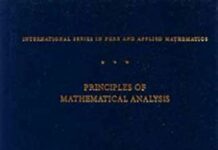
Ebook Info
- Published: 1986
- Number of pages: 483 pages
- Format: PDF
- File Size: 6.18 MB
- Authors: Walter Rudin
Description
This is an advanced text for the one- or two-semester course in analysis taught primarily to math, science, computer science, and electrical engineering majors at the junior, senior or graduate level. The basic techniques and theorems of analysis are presented in such a way that the intimate connections between its various branches are strongly emphasized. The traditionally separate subjects of ‘real analysis’ and ‘complex analysis’ are thus united in one volume. Some of the basic ideas from functional analysis are also included. This is the only book to take this unique approach. The third edition includes a new chapter on differentiation. Proofs of theorems presented in the book are concise and complete and many challenging exercises appear at the end of each chapter. The book is arranged so that each chapter builds upon the other, giving students a gradual understanding of the subject. This text is part of the Walter Rudin Student Series in Advanced Mathematics.
User’s Reviews
Reviews from Amazon users which were colected at the time this book was published on the website:
⭐This year we have been using the 1987 third edition of Walter Rudin’s treatise as the main text for a standard first-year graduate sequence on real analysis, backed up by Wheeden/Zygmund’s book on Measure and Integral, and the two seem to complement each other quite nicely. Rudin writes in a very user-friendly yet concise manner, and at the same time he masterfully manages to maintain the high level of formality required from a graduate mathematics text. To be totally honest, a few years ago my very first attempt at learning graduate-level real analysis in a classroom setting (via Folland’s book) was not successful, as I found the exposition in Folland very dense and rigid, and the homework problems too difficult to do. Rudin’s book however, is a lot more accessible for the beginning graduate students who may not have had any more than some basic exposure to measure theory in their upper division analysis classes. (I will inevitably be making a few comparisons between the two texts in the following.) One point to keep in mind though, is that Rudin developes the measure in a more formal axiomatic direction, instead of in the more concrete, constructive approach. In the constructive approach, one first introduces the “subadditive” outer measure as a set function which is defined on the power set P(X) of a nonempty set X. One then proceeds by showing that the restriction of the domain of the outer measure to a smaller class of subsets of X (a sigma algebra M), obtained via applying the Caratheodory’s criterion, results in a “countably additive” set function which is called a measure on (X, M) (The latter is the approach also taken in both H.L. Royden and Wheeden/Zygmund). The formal approach is not very intuitive and is less natural for a beginning graduate student who might not have developed some level of mathematical maturity yet.Also, Rudin does not discuss some of the more advanced or interdisciplinary topics such as distribution theory (Sobolev spaces, weak derivatives, etc.) or applications of measure theory to the probability theory, both explored in the book by Folland. Last but not least, it’s worth noting that contrary to the common practice, Folland includes many end-of-chapter notes where he outlines some important historical aspects of the development of the topics, and also gives a few references for further study. For example, in the notes section at the end of the chapter on Lebesgue integration, he mentions –and briefly outlines– the basics of the theory of “gauge integration” (aka Henstock-Kurzweil theory) which serves to construct a more powerful integral than that of the Lebesgue’s. As another instance, having already defined and used “nets” within the chapter on topology, in the end-notes Folland also introduces “filters” and “ultrafilters”. These are all machineries which have been developed to play the role of the metric space sequences in general (locally Hausdorff) topological spaces, but for some historical reasons, ultrafilters have nowadays taken a backseat to the nets (the older general topology books usually prove the Tychonoff theorem using ultrafilters). All said, I can recommend taking up Royden as your very first approach to measure theory, then based on how well you think you have learned the first course, move on to either Rudin or Folland for a more advanced treatment. Please note that the other books I have mentioned above do not discuss complex analysis, a subject which is also masterfully presented in Rudin. There are however a few other equally well-written complex analysis books to pick from, for example John B. Conway’s classic from the Springer-Verlag graduate text series, or L.V. Ahlfors’s wonderful monograph, to name just a couple.
⭐Rudin’s Real and Complex Analysis is my favorite math book. I’ve studied it thoroughly as an undergrad/early grad student when I was training to be a research mathematician working in complex and harmonic analysis.Like much of Rudin’s other writings, this book is written from an advanced perspective. This often leaves newcomers to analysis and first year graduate students scratching their heads in confusion, and it’s partly the reason why it’s rarely used in qualifying exam sequences when compared to Folland’s text. However, if you plan to use analysis in your research, then Rudin will give you a perspective that is difficult to find in other places.In particular, his treatment of real analysis in the first 9 chapters is heavily influence by functional analysis. This is most striking in chapter 2, where he proves the Reisz Representation Theorem which shows an equivalence between positive measures and positive linear functionals (hiding within this generality is a construction of the Lebesgue Measure). Another example of this is his treatment of Fourier Series/orthogonal decompositions of L^2 in chapter 4.The same trend continues in the complex analysis section of the text. Here, the presentation of the material is heavily influence by H^p space theory. For instance, he gives a treatment of harmonic extension via convolving with the Poisson measure, something you’ll find in chapter 1 of any H^p space book like Koosis. He even has a chapter on H^p space theory. His treatment of the basics of complex analysis uses real and functional analysis freely. If I recall correctly, his proof of Runge’s Theorem uses the Hahn-Banach Theorem.So this book has an almost orthogonal treatment of complex analysis to the more traditional, geometry-based, texts like Alhfors, Gamelin, or Krantz’s. I think the geometry-based approach is best for a first-semester course in complex analysis, but the student interested in analysis should probably work through chapters 10 onward in their own free time at some point before research gets too heavy.As is usual for Rudin, the writing is sharp and clean. On a first read, it may seem too crisp, but then the reader grows in understanding, and then the writing appears perfect. The exercise sets are great, as is usual for Rudin. Bashing your head against these problems will definitely improve your thinking.In short, Rudin’s Principles of Mathematical Analysis made me want to be an analyst, but his Real and Complex Analysis taught me how.
⭐The actual material is excellent and a classic. When I read it as a grad student it was also beautifully printed, with a nice embossed cover and high-quality paper. It was probably the nicest textbook I owned.Unfortunately I lost all my belongings and have had to replace my math books. And McGraw-Hill seems to have lost its integrity. As you can see, the photos here are not the same as the photos on Amazon (which are of the high-quality printing). The most obvious giveaway is the printed red “McGraw-Hill” on the spine – on Amazon this part is gold and embossed. But the entire cover is a cheaply laminated low-quality printing. The paper quality is also much lower – not dirt-cheap but it feels more like printer paper than “Rudin paper.” I am a book dork and have fond memories of the way this book felt in my hands. It’s always ridiculous to spend $100 on a relatively small book, but the craftsmanship used to justify the price. Very disappointing to see that this book is now part of the standard grad student textbook racket.I have not noticed any QC problems like misprints or missing pages, and everything is quite readable. The paper is cheap but seems fairly robust to tears. So the book is not a terrible con job, but Amazon should really update the picture – and drop the price!Until then you should try to find it used, with the nicer cover.
⭐They make you believe that you are buying the book from the picture which is a very nice book with high standards printing qualities. However you get a cheaper version of that book. For the price you paid is totally unfair.This book is very good and very hard at the same time. It covers a lot of material, which is taught by real and complex analysis course along 2-4 semesters. It comes in good condition, just like new.
⭐The book is very well written and is a great challenge for anyone who wants to engage in real analysis. I personally read it a page a day.
Keywords
Free Download Real and Complex Analysis (Higher Mathematics Series) 3rd Edition in PDF format
Real and Complex Analysis (Higher Mathematics Series) 3rd Edition PDF Free Download
Download Real and Complex Analysis (Higher Mathematics Series) 3rd Edition 1986 PDF Free
Real and Complex Analysis (Higher Mathematics Series) 3rd Edition 1986 PDF Free Download
Download Real and Complex Analysis (Higher Mathematics Series) 3rd Edition PDF
Free Download Ebook Real and Complex Analysis (Higher Mathematics Series) 3rd Edition




